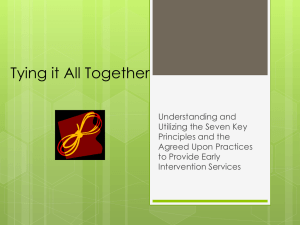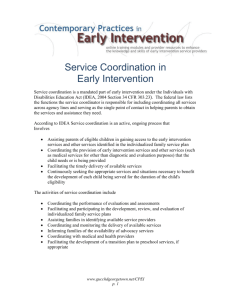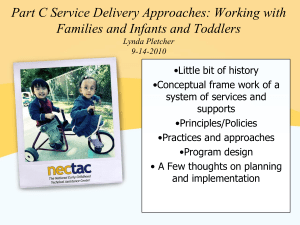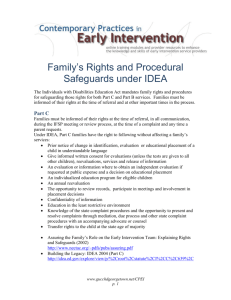Key Principles & Practices for Providing Early Intervention Services
advertisement
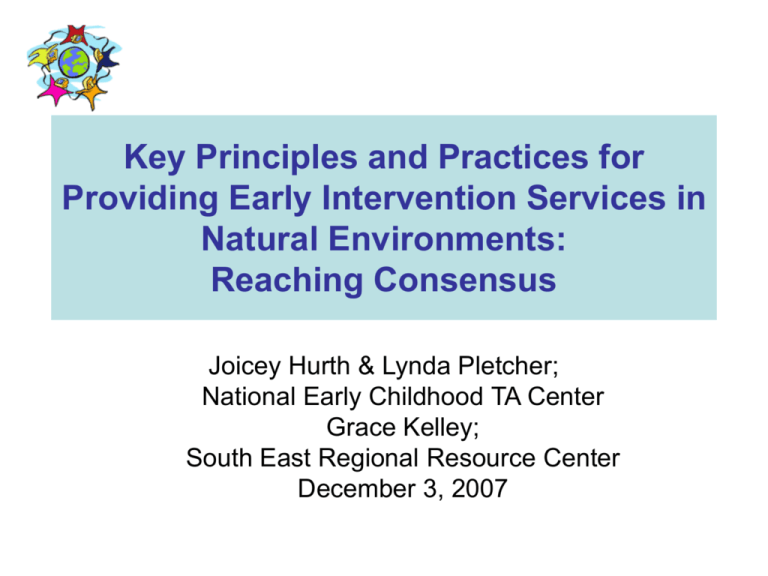
Key Principles and Practices for Providing Early Intervention Services in Natural Environments: Reaching Consensus Joicey Hurth & Lynda Pletcher; National Early Childhood TA Center Grace Kelley; South East Regional Resource Center December 3, 2007 Today’s Purpose • Share and review work completed by CoP Work group • Compare participants current practices in their state’s to the agreed upon principles and practices • Discuss how this work could assist their state to enhance services • Discuss strategies and next steps Introduction OSEP sponsored TA Community of PracticePart C Settings: www.TACommunities.org • Sponsored by the Office of Special Education Programs, US Dept. of Ed. This community facilitated by: National Early Childhood TA Center (NECTAC); Southeast Regional Resource Center (SERRC) and Region 6 Parent Information and Training Center (PTI) The Identified Need • Examine the various “models” of providing services in natural environments- how are they the same? • Reach consensus on key principles (foundations) • Identify the research-base on effective practices • Identify common practices and leanings that the research , model development projects and the “wisdom ”from the field suggest • Describe the agreed upon practices that are “model neutral” • Describe some examples of how would you know this practices is being implemented Community Of Practice Workgroup On Principles and Practices In Natural Environments Group of volunteers came together after national meeting in 2006 to form workgroup: Susan Addision, Betsy Ayankoya, Mary Beth Bruder, Carl Dunst, Larry Edelman,Andy Gomm, Barbara Hanft, John Hoffman, Cori Hill, Joicey Hurth, Grace Kelley, Anne Lucas, Robin McWilliam, Stephanie Moss, Lynda Pletcher, Dathan Rush, M’Lisa Shelden, Mary Steenberg, Judy Swett, Nora Thompson, Julianne Woods, and Naomi Younggren •Conference calls •“Think Tank” working meeting in July 2006 •Provided input and edits on the various documents Work still to be completed: – Determine various uses of the current materials and develop some written guidance – Identify the skill sets necessary to implement practices – Review existing training and or other resources for “matches”- what's already out there in states? – Find a grant to pull together existing (or write) training resources – Work with state’s systems through a variety of methods to address policy/procedures and training issues for overcome barriers to implementation Four Documents and the Status • Mission and Key Principles of Early Intervention Services ( 5th and Final Draft) • Seven Key Principles & Looks Like/Doesn’t Look Like (3nd Draft) • Agreed Upon Practices For Providing Early Intervention Services In Natural Environments (5th and Final Draft) • Research that Support Key Principles (2nd Draft) Mission and 7 Key Principles of Early Intervention Services • MISSION- The overarching reason for an early intervention system of services •PRINCIPLES- the foundations or beliefs which support all our work with children and families Looks/Like Doesn’t Look like • Key concepts behind the principle • Examples of what the principle might look like in practice • Provides descriptions of what it “doesn’t look like” because too often such practices are still being used • Can be use as a training tool • This is not a consensus document but workgroup members provided many of the examples Example of A Principle & Key Concepts 5. IFSP outcomes must be functional and based on child and family needs and priorities Key Concepts: • Functional outcomes improve participation in meaningful activities • Functional outcomes build on natural motivations to learn and do; fit what’s important to families; strengthen naturally occurring routines; enhance natural learning opportunities. • The family understands that strategies are worth working on because they lead to practical improvements in child & family life Example: III. The primary role of the service provider in early intervention is to work with and support the family members and caregivers in a child’s life. Looks Like Doesn’t Look Like • Using professional behaviors that build trust and rapport and establish a working partnership with families. • Providing information, materials and emotional support to enhance family’s natural role as the people who foster their child’s learning and development. • Being nice to families and becoming their “friend” • Training families to be “mini” therapist or interventionist See Hand-out Agreed Upon Practices • Intended for any service provider to use from the beginning of their involvement with child/family • Reflects Consensus of Group • Model neutral • Reflective of research, practice and “wisdom from the field and families (evidence based practices) • Includes legal requirements • Document is divided into three sections of Service delivery Agreed Upon Practices, (cont) • Numbered statements are what a provider “should” do • The first numbered statement in each section sets the stage for the more detailed, bulleted statements that follow • Bulleted statements are examples of the behaviors- how you would see this practice being implemented? • This is NOT a checklist of everything, but there is a “flow”. Sample First Contacts with Families from Referral to the IFSP Meeting 1. Become acquainted and establish rapport Use social behaviors that are warm and welcoming and respectful of family culture and circumstances. Balance the time listening to the family with sharing information. Ask what language the family usually speaks (mode of communication) and if any family members may want an interpreter. Explore their level of comfort with written documents. Express willingness to explore family concerns and work with them to find solutions. Research that Support Key Principles • • • • Very much a draft document Citations suggested by work group Needs verification Currently available: – A searchable annotated bibliography on the NECTAC Inclusion Web page – A compilation of the “top 10” articles recommended by the Researchers/Trainers on the Natural Environments Call Series Instructions: Group work on Practices: 1. Look over your assigned section 2. Use worksheet to jot down practices and behaviors you do, or think your providers do, now. Rate 3. Note links to training materials, guidance documents policies procedures you already have in place that would support these practices. 4. Discuss at the table Report Out • Of the practices,which are happening well in your state or local program? • Which of the practices are not happening? • If Not/ Why not? Discussion • Potential use of these Documents in current form/changes? • Further development? For what purpose? • How do we build on this work? Documents available for dissemination • Located on: • www.nectac.org/topics/families/families.asp • Feedback or comments: Lynda_pletcher@unc.edu • Please let us know how you are using documents Resources • Link to annotated bibliography http://www.nectac.org/inclusion/search/inclubibin tro.asp • Link to state documents (guidelines and Policies) http://www.nectac.org/inclusion/legis/stlegis.asp • Link to National Conference Call series http://www.nectac.org/~calls/2004/partcsettings/ partcsettings.asp
